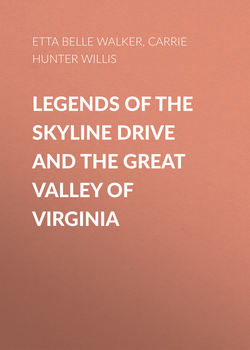Читать книгу Legends of the Skyline Drive and the Great Valley of Virginia - Etta Belle Walker - Страница 11
Winchester—The Frontier Town of the Valley
ОглавлениеThe first inhabitants of Winchester were a large tribe of Shawnee Indians. Two houses occupied by white men are supposed to have been standing as early as 1738.
Known as Old Town and Fredericktown it was named Winchester in 1752 in honor of the English home of its founder, Colonel James Wood. The settlement grew so rapidly it was necessary several times to enlarge its boundaries. Colonel Wood and Lord Fairfax both donated additional lots in order to extend the corporate limits of the town.
During the French and Indian War Colonel George Washington was asked to go to Winchester to defend the Valley. He found refugees overrunning the place and determined to build a fort on the outskirts of the town which would afford protection in case of raids. He imported his own blacksmith to do the foundry work, so anxious was he to speed the construction of the fortifications. Fort Loudon was the name given, after Lord Loudon the commander of the colonial forces, and a successful defense was made against the French there. It may be of interest to learn that the fort's bastion still remains and the well which supplied water during the French and Indian War is still in use today.
No account of Winchester would be complete if the story of General Daniel Morgan were omitted. Of Scotch-Irish extraction he came with his parents from New Jersey to the new settlement. As a youngster he was considered something of a bully. The story goes that around "Battletown," an intersection in the roads where toughs used to fight for the joy of combat, young Morgan was in the habit of placing large stones at strategic points. In case he had to retreat he was able to draw on this supply of ammunition!
Tradition has it that on one occasion young Dan Morgan had just arrived in Winchester from the Western settlements on the South Branch—as a driver of a pack for the fur traders. George Washington was ready with his small party to go to the Ohio Country with a message to the French officials not to continue their fort building on English property.
Washington's journal gives the following notes: "On Ye 17th day of Ye month of Novemo,—the party consists of one guide and packer, one Indian interpreter, one French interpreter and four gentlemen." We know now that the celebrated Gist was his guide and Vanbraam his interpreter. It is said that Morgan offered his services too as a guide, and was accepted. It was on this perilous trip, perhaps, that each of these young men realized the fine traits of the other.
It was Daniel Morgan who, at the outbreak of the Revolution, marched a hundred men with one wagon of supplies to Boston to report to General Washington. He fought at Quebec and Saratoga and defeated Tarleton at Cowpens. He had charge of Hessian prisoners captured at Saratoga and there are evidences yet of his supervision of construction of stone walls and homes and the mill at Millwood built with prisoner labor.
"Saratoga" is the name he gave his home near Boyce; it was built mainly by the Hessian artisans. On his way to Gettysburg in 1863 General Lee used the fine old house as headquarters. This estate is on the road between Winchester and Boyce and is in full view of the highway.
There is a wealth of amusing tales told about the old city, some dating as far back as its conception; others have to do with the activities of later times.
The story is still heard in Winchester of the time when guests and village loafers were congregated in one of the taverns at the close of a day to discuss weighty topics over their glasses of ale. From a window they saw an old man get out of his gig, taking with him luggage for overnight accommodation. The gig was comparable to the famed One Horse Shay in its state of near collapse. Comments were passed among the group inside as to the man's shabby appearance, his business and ultimate destination. He was soon forgot in the midst of the ensuing conversation between several young lawyers, one of whom remarked that he had heard a sermon delivered which equalled the eloquence and fluency usually reserved to lawyers pleading their cases. This brought forth eventually a heated discussion of the merits of the Christian religion, argued pro and con by those present lasting from six in the evening till eleven.
Finally one young fellow turned to the quiet old traveller. The latter had sat with apparent interest and meekness throughout the five-hour debate and had not joined in. The question was asked, "Well, old gentleman, what's your opinion?"
The reply lasted almost an hour; he answered argument for argument in the exact order in which each had occurred and with the greatest simplicity and dignity. At the conclusion no one spoke for some time. At last inquiry was ventured as to his identity. He was Chief Justice John Marshall.
In his Virginia: A History of the People John Esten Cooke relates this story. An Irish laborer and his wife came in 1767 to the lower valley country and stopped at the home of a Mr. and Mrs. Strode, German landowner. For several years they lived with the German family and during the time a son was born. When they decided to push on farther south the Strode children followed, begging that they leave the little boy behind with them. They had become very much attached to the baby and were reluctant to see him go away. The parents naturally refused the request. While stopping for a short rest they placed the baby on the ground and the children would have run off with him if they could.
